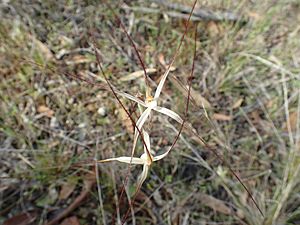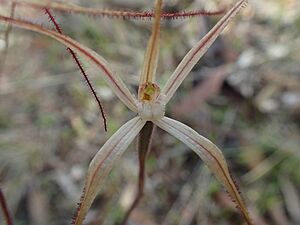Western wispy spider orchid facts for kids
Quick facts for kids Western wispy spider orchid |
|
|---|---|
 |
|
| Caladenia microchila growing near Ravensthorpe | |
| Scientific classification | |
| Genus: |
Caladenia
|
| Species: |
microchila
|
| Synonyms | |
|
|
The Caladenia microchila, often called the western wispy spider orchid, is a unique type of orchid. It grows only in the south-west part of Western Australia. This orchid is quite common in its native area. It has a single, upright, hairy leaf. Its delicate white flowers have narrow, wispy side parts called lateral sepals and petals. The flower also has a white "lip" part, known as a labellum, which has red markings.
Contents
What the Western Wispy Spider Orchid Looks Like
The western wispy spider orchid is a plant that grows from the ground. It is a perennial plant, meaning it lives for more than two years. It is also deciduous, so its leaves fall off at certain times. This plant has an underground tuber, which is like a small storage root. From this tuber grows a single, upright, hairy leaf. This leaf is usually about 80 to 120 millimeters (3 to 5 inches) long and about 2 millimeters (0.08 inches) wide.
Each plant can have up to three white flowers. These flowers are about 30 to 90 millimeters (1 to 3.5 inches) long and 30 to 60 millimeters (1 to 2.5 inches) wide. They grow on a stalk that is 90 to 250 millimeters (3.5 to 10 inches) tall.
The sepals and petals of the flower have long, thin, thread-like tips. These tips are dark reddish-brown. The top sepal, called the dorsal sepal, stands straight up. It is about 35 to 70 millimeters (1.4 to 2.8 inches) long and 2 millimeters (0.08 inches) wide. The side sepals are 45 to 70 millimeters (1.8 to 2.8 inches) long and 2 to 3 millimeters (0.08 to 0.12 inches) wide. They point stiffly downwards. The petals are 25 to 60 millimeters (1 to 2.4 inches) long and about 2 millimeters (0.08 inches) wide. They are held either flat or slightly upwards.
The labellum, or "lip," of the flower is 4 to 7 millimeters (0.16 to 0.28 inches) long and 4 to 5 millimeters (0.16 to 0.20 inches) wide. It is white with red stripes and spots. The very tip of the labellum curls underneath. The sides of the labellum have small, blunt teeth. There are also two rows of cream-white, anvil-shaped bumps called calli along the center. Sometimes, these calli have red tips. This orchid usually flowers from July to early October.
How the Western Wispy Spider Orchid Got Its Name
The Caladenia microchila was first officially described in 2001. This was done by two scientists, Stephen Hopper and Andrew Phillip Brown. Their description was published in a science journal called Nuytsia.
The second part of its scientific name, microchila, comes from two Ancient Greek words. Mikros means "small," and cheilos means "lip." This name refers to the relatively small labellum (lip) of this orchid species.
Where the Western Wispy Spider Orchid Lives
The western wispy spider orchid grows in an area between Kondinin and Madura. This area covers several different natural regions in Western Australia. These regions include the Avon Wheatbelt, Coolgardie, Esperance Plains, Hampton, and Mallee areas.
This orchid can be found in various places within these regions. It often grows near granite rock formations and along the edges of salt lakes.
Conservation Status
The Western Australian Government's Department of Parks and Wildlife has looked at the Caladenia microchila. They have officially classified it as "not threatened." This means the species is currently not in danger of disappearing.


